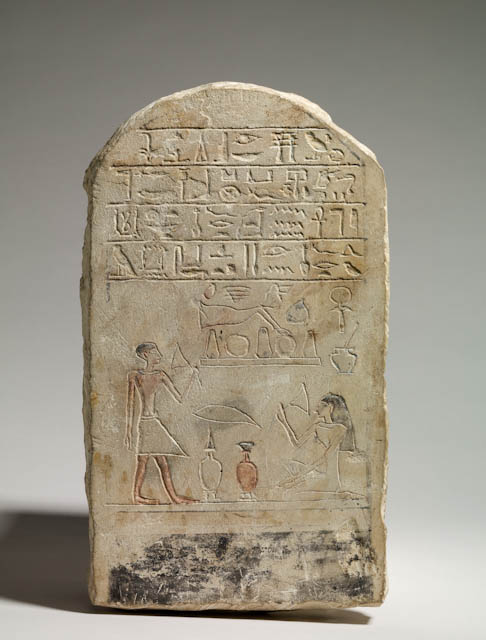| Maker(s): | Unknown | | Culture: | Egyptian
| | Title: | Stela of Sebek-Hotep
| | Date Made: | 1782-1650 BCE (Second Intermediate Period, Dynasty 13)
| | Type: | Sculpture
| | Materials: | Limestone
| | Place Made: | Africa; Egypt; Abydos (possibly)
| | Measurements: | Overall: 13 3/4 in x 7 5/8 in x 2 3/4 in; 34.9 cm x 19.4 cm x 7 cm
| | Narrative Inscription: | The inscription reads: "An offering which the king gives (to) Osiris, lord of Busiris, the great god, lord of Abydos, that he may grant invocations offerings consisting of bread, beer, cattle, fowl, alabaster and clothing, and every good and pure thing on which a god lives, for the ka of Sebek-hotep, justified, born of Nofret. (translated by Diana Wolfe Larkin)
| | Accession Number: | MH 1910.9.A.G
| | Credit Line: | Purchase with Acquisition Fund
| | Museum Collection: | Mount Holyoke College Art Museum
|
|

Currently on view |
Description:
Limestone stela shaped like a tall rectangle with a half-round top. Upper portion is inscribed with hieroglyphs. Middle portion has a scene in sunk relief showing a man on the left, standing facing right, and a woman on the right, seated facing left. Around them are various objects of everyday life, including food offerings, a mirror, a cosmetic vessel with applicator, and two tall jars on ring stands. The hair and skin of the figures is colored with fading black and reddish brown paint, respectively. Figures both hold a lotus to the face. Lower portion painted black, but very worn.
Label Text:
In ancient Egypt, brightly painted relief sculpture decorated temple and tomb walls as well as upright monuments known as stelae. One fragment from a tomb wall—now lacking its original polychromy—shows an Old Kingdom nobleman with the eternally youthful features favored in much Egyptian art. The stela of Sebek-hotep, made more than 800 years later at the end of the Middle Kingdom, honors a man of relatively low rank who is shown at his funerary banquet with a female relative. Above, a prayer requests food offerings for his use in the afterlife. The likeness of King Amenhotep I and a cartouche with his name appear on a stela fragment that dates not to his reign (ca. 1551–1524 BCE), but to later in the New Kingdom, when the deceased ruler was worshipped as a patron by craftsmen at the Theban royal tombs. The adjoining fragment with the rest of the king’s body and the figure of his mother, Queen Ahmose-Nefertari, is now in the Egyptian Museum in Turin, Italy.
2016
Tags:
ancient; archaeology; tombs; deaths; afterlife; religion; food; cosmetics Subjects:
Religion; archaeological objects; Civilization, Ancient; Death; Food; Future life; Tombs Link to share this object record:
https://museums.fivecolleges.edu/detail.php?t=objects&type=ext&id_number=MH+1910.9.A.G |